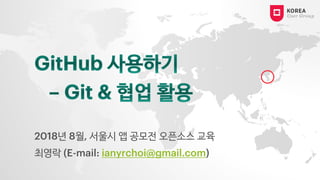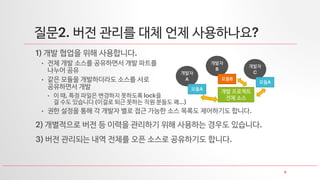[201808] GitHub ???? - GIt & ?? ??
- 1. 2018? 8?, ??? ? ??? ???? ?? ??? (E-mail: ianyrchoi@gmail.com)
- 2. 2 ?? ? ??? ??? ? Git? ????? ? GitHub? ????? ? GitHub ?? ?? ?? (Demo) ? ??? ? ?? ???? (iOS, Android, Fusetools, ˇ) ? ?? ????? ??? ?? ? ?? ???? ????? ??? ???? ??
- 3. 3 ??? ??? ¨C (1) ? ??, git? ??? ?? ?? ??, ???? ?? ???? ????. ? ? ?? ? (??/???? ??? ????) ??? ??: yes24.com, ????? (????)
- 4. 4 ??? ??? ¨C (2) ? ???? ? Git? ???? ?? ?? ???, ??? ???! ? http://rogerdudler.github.io/git-guide/index.ko.html ? Git-scm: http://git-scm.com/book/ko/v1 ? Atlassian git tutorial (??): https://www.atlassian.com/git/ ? ??? ?? ???? ????: https://learngitbranching.js.org/?locale=ko ? ?? ???? ? ?? ??? ??? ? ?? ???? ?? DVCS ¨C Git ? http://www.slideshare.net/ibare/dvcs-git ? Svn ???? ?? git ?? ??? ? http://www.slideshare.net/einsub/svn-git-17386752 ? Subversion vs. Git: ??? ?? ?? ? http://www.slideshare.net/ienvyou/subversion-vs-git-42605130
- 5. 5 ??, ? ??? ???? ? ?? ???? ? Git? ?? ????? ? GitHub? ???, Git?? ?? ??? ? ?? ???? ????? ???.. Git? ??? ? ????? ? ? ??? ??? ? Branch, Tag ?? ??? ????? ? Merge? Rebase? ???.. ? Pull, Push, Pull Request? ? ˇ + ??? ? ??? ??? Git / GitHub ???? ? ?? ????? ?
- 6. 6 (???? ?, ? ?? ??!) ? ?? ???? ??? ?? ??? ??? ?? ?? ?? ?? ????. ? ?? ??? ?? ????, ?? ???? ?? ??? ??? ???? ianyrchoi@gmail.com ?? ????? ??? ??/????? ???. ?
- 7. 7 Git? ????? ? Git ? ?? ??? ?? ?? ? ??? ??? ???, ??? ????? ?? ??? ? BitKeeper?? ?? ??? ?? ???? ?? ??? ???? ?? ??? ????? ?? ??? ???? ? ??? ??: http://izquotes.com/quote/273567
- 8. 8 ??1: ?? ??? ?????? ? ?? ?? ?? ??? ??? ???? ???? ?????. ? ??/??? ??/??/???? ??? ?? ??? ???? ????? ?? ? ??? ? ?? ?? ?? ??? ??? ? ? ?? ? ?? ??? ?? ??? ?? ?? ??? ??? ??? ??? ?? 1? ?? ?? ? ?? ?? 1? ?? ?? ? ?? (?? 1) (?? 2) (?? 3)
- 9. 9 ??2. ?? ??? ?? ?? ?????? 1) ?? ??? ?? ?????. ? ?? ?? ??? ????? ?? ??? ??? ?? ? ?? ??? ?????? ??? ?? ????? ?? ? ? ?, ?? ??? ???? ???? lock? ? ?? ???? (??? ?? ??? ?? ??? ?ˇ) ? ?? ??? ?? ? ??? ?? ?? ??? ?? ??? ????? ???. 2) ????? ?? ? ??? ???? ?? ???? ??? ????. 3) ?? ???? ?? ??? ?? ??? ????? ???. ??? A ??A ??? B ??B ??? C ??A ?? ???? ?? ??
- 10. 10 ??3. ?? ?? ?? ????? ? ?? ?? ?? ?? ?? ? CVS: 90?? ? ¨C 2000???? ?? ??? ????? ??? ?? ?? ?? Subversion (SVN)? ?????? ?? ???? ?? ??? ? ?? ? Subversion (SVN): ?? ?? ??? ? ?? ? ?? (???, atomicity), ?? ?? ??, rename (?? ?? ??? ????) ? CVS? ?? ??? ?? ??? ???? ?? ????? CVS?? ??? ??? ?? ????. ???? ?? Git? ?? ???? ? ?? ?????? ?? ?? ?? ? Mercurial: Git? ??? ?? ?? ?? ?? ???? ???. ? ?? ?? ?? ?? ? ?? ? ? ? Microsoft Visual SourceSafe? Team Foundation Server??..
- 11. 11 ??4. ˇ®??ˇŻ ?? ?? ??? ?? ????? ? ?? ???? ?? ?? Subversion? Git? ?? ?????. ? Subversion? ?? ??? ??? ??? Subversion ??? ???? ??? ???? ???. ? ??, Git? ????? ?? ??? ?? ??? ????? ?? ??? ?? ???? ??? ? ? ??? ???? ???. ? ?? ???? ?????. ??? ????? ???? ??? ???? ??? Git? ???? ??? ??? ? ??, ??? ??? ?? ?? ?? ??? ? ???? ??? ? ?? ???.. ?? ??? ???? ?? ? ?? Git? ????? ?? ?? ????ˇ ˇú ???, ??? Git? ?? ????? ?
- 12. 12 ??5. Git ????? ? ??? ???? ? ??? ????? ?????. ? ??? Git? ? ??? ????? ?? ??? ?? ???. ? ??? ????? ??? pull, push, commit ?? ?? ??? ?? ? ? ?? ?? GUI?? ????. ? TortoiseGit, gitk, Sourcetree, GitHub Desktop, ˇ ? ??? ???? ?? ????? ?? ????. ?
- 13. 13 Git ?? ?? ¨C (1) ? Pull ? Git ??? ????? ? ??? ??? ?? ?? ??? ????. ? Commit ? ??/??/??? ??/???? 1? ???? ???? ? ??? ??? ?? ??? ????. ? Push ? ? ??? ??? ???? ?? ?? ??? Git ??? ??? ???.
- 14. 14 Git ?? ?? ¨C (2) ? Branch ? ???? ??? Branch?? ???. ? ??? master???. ? ? ??? ?? ?? Branch? ?? branch, ?? ??? ?? Branch? ??? branch?? ???. ? Tag ? Branch? ??????? ??? ?? ??? ???? ?? ???? ?????. ? ?? Tag? ?? ?? ??? ?? ??? ?? ??? ? ??? ??? ??? ?? ? ????.
- 15. 15 Git ?? ?? ¨C (3) ? Branch? Tag? ?? ?? ? OpenStack neutron ??
- 16. 16 Git ?? ?? ¨C (4) ? Merge ? Git? ?? ??? ???? 1) ?? ???? ?? ??? ??? ??? ?? 2) ?? ?? Branch? ??? ??? ??? ????. ? ?? ?? ??? ??? Merge?? ???.
- 17. 17 Git ?? ?? ¨C (5) ? Rebase ? Git ?? ?? ?? ?? ? ??? Git ??? ??? ? ??? ?? openstack ??: commit ?? ryu-book ??: commit ??
- 18. 18 GitHub?? ? http://www.github.org ? Git ???? ?? ???? ?? GitHub? ?? ?? ?????. ? ??? GitHub? ??? Git ?? ????? ????? ???? ?????.
- 19. 19 ? ?? ?? GitHub? ?? ? ?? Web UI? ?????. ? gh-pages Branch? ??? ??? [???].github.io/[????] ????? ?????. ? ?? ?? & ??, ?? ??? ???? ?? Issues ??? ?? ? Wiki ?? ? ? ???? ?? ?? ???? ?? ?? ??? ?? ? ?? ? ?? ?? ??? ??? organization ??? ?? (??? ??) ? ˇ (?? ???ˇ)
- 20. 20 GitHub - fork ? ?? ?? ???? ??? ? ???? ??? ?? ?????. fork
- 21. 21 GitHub - fork? ????? Pull : ???? [? ???] (??? ??..) Pull : ???? Push : ???Push : ??? Fork? ??? ?????. ??? ??? ? ???? ??? ?? ??????
- 22. 22 GitHub ¨C pull request Pull : ???? [? ???] (??? ??..) Pull : ???? Push : ??? Pull request : ?? ????? ? ??? ??? ?? ??? ?? ?? ???? ?? ?? ???? ??????, ??/?? ?? ?????.
- 23. 23 GitHub ?? ?? ?? ¨C ??? ? ?? ? GitHub Desktop?? ? ???: https://desktop.github.com
- 24. 24 GitHub ?? ?? ?? ¨C ??? ? ?? ? ??? ???? ??? ?? ????? ??? ????. ????? ???!
- 25. 25 GitHub ?? ?? ?? ¨C ??? ? ?? ? GitHub ???? ?????? (???, ??? ????)
- 26. 26 GitHub ?? ?? ?? ¨C ??? ? ?? ? ??: 2-factor authentication? ??? ?????
- 27. 27 GitHub ?? ?? ?? ¨C ??? ? ?? ? ?? ???? ???? ??? ?? ? ??? ??? ?????
- 28. 28 GitHub ?? ?? ?? ¨C ??? ? ?? ? 3?? ??? ????: GitHub? ?? ?? / ??? ?? / GitHub?? ????
- 29. 29 GitHub ?? ?? ?? ¨C ??? ? ?? ? ???? ???: ??/??/?? ?? ?? + README, .gitignore, ????
- 30. 30 GitHub ?? ?? ?? ¨C ??? ? ?? ? ???? ?? ?? (???? ?? ??, GitHub? ?? ? ??)
- 31. 31 GitHub ?? ?? ?? ¨C ??? ? ?? ? ??? ?? ?? ?? (??/commit)
- 32. 32 GitHub ?? ?? ?? ¨C ??? ? ?? ? GitHub? ???
- 33. 33 GitHub ?? ?? ?? ¨C ??? ? ?? ? GitHub ? ????? ??
- 34. 34 GitHub ?? ?? ?? ¨C ??? ? ?? ? ???? ??? ??? ????
- 35. 35 GitHub ?? ?? ?? ¨C ??? ? ?? ? ?? ??? ???? ?? (<50?), ?? ??? ????? (??/commit)
- 36. 36 GitHub ?? ?? ?? ¨C ??? ? ?? ? ??? ??? ?? (GitHub.com ??? ?? ? ??)
- 37. 37 GitHub ?? ?? ?? ¨C ??? ? ?? ? GitHub.com?? ???? (??/push)?? ?? ??? ? ??
- 38. 38 GitHub ?? ?? ?? ¨C ??? ? ?? (??) ? ??? ?? ? ??? ???? ?? vs. ?? ??? ?? ???? ??? ?? ?? ? README ??? ? ??? ?? ? (?? README.md - Markdown ???? ??) ? LICENSE ?? ??? ??? (GPL, LPGL, Apache, MIT, ˇ) ? .gitignore ??? ? ?????! (??? ?? ??? git ?? ???) ? ?? ??? ?: ˇ°??ˇ±? ?? ??? ????? ? ?? ??? ?? ?????: ???? ˇ°??ˇ± ? ??? ??
- 39. 39 ??: README ?? ???? ? README.md ?? README.rst ??? ??? ?? ??? ?? ? ??? md: ???? ?? ? ??? rst: Restructured Text ?? (Python ?????? ?? ??) ? ??? ???? ?? ?? ?? ??? ???? README? ??? ??
- 40. 40 ??: LICENSE ?? ? ?? ????? ???? ??? ???
- 41. 41 ??: .gitignore ?? ? ?: iOS? Android ????? ?? ?? (? ? ??? ??)
- 42. Finished!



















![19
? ?? ?? GitHub? ??
? ?? Web UI? ?????.
? gh-pages Branch? ???
??? [???].github.io/[????]
????? ?????.
? ?? ?? & ??, ?? ??? ???? ?? Issues ??? ??
? Wiki ??
? ? ???? ?? ?? ???? ?? ?? ??? ??
? ?? ? ?? ?? ??? ??? organization ??? ?? (??? ??)
? ˇ (?? ???ˇ)](https://image.slidesharecdn.com/201808github-gitandcollaboration-180825003942/85/201808-GitHub-GIt-19-320.jpg)

![21
GitHub - fork? ?????
Pull
: ????
[? ???]
(???
??..)
Pull
: ????
Push
: ???Push
: ???
Fork? ??? ?????.
??? ??? ? ???? ??? ?? ??????](https://image.slidesharecdn.com/201808github-gitandcollaboration-180825003942/85/201808-GitHub-GIt-21-320.jpg)
![22
GitHub ¨C pull request
Pull
: ????
[? ???]
(???
??..)
Pull
: ????
Push
: ???
Pull
request
: ??
?????
? ??? ??? ?? ??? ?? ?? ????
?? ?? ???? ??????, ??/?? ?? ?????.](https://image.slidesharecdn.com/201808github-gitandcollaboration-180825003942/85/201808-GitHub-GIt-22-320.jpg)




































![[Unite2015 ???] ??? ??? ??? ???](https://cdn.slidesharecdn.com/ss_thumbnails/unite2015-150417010741-conversion-gate02-thumbnail.jpg?width=560&fit=bounds)





![[??????] ???????](https://cdn.slidesharecdn.com/ss_thumbnails/20160528-160529034614-thumbnail.jpg?width=560&fit=bounds)















![[17.02.09] Github introduction (Korean Version)](https://cdn.slidesharecdn.com/ss_thumbnails/githubintroduction-170502020242-thumbnail.jpg?width=560&fit=bounds)



![[????? SODA]?(git) ?? ? ????(sourceTree) ??](https://cdn.slidesharecdn.com/ss_thumbnails/pdf-171116120939-thumbnail.jpg?width=560&fit=bounds)














![[OpenInfra Days Vietnam 2019] Innovation with open sources and app modernizat...](https://cdn.slidesharecdn.com/ss_thumbnails/innovationwithopensourcesandappmodernizationfordevelopers-dist-190824044544-thumbnail.jpg?width=560&fit=bounds)



![[OpenStack] ?? ????? ???? ?? & ????](https://cdn.slidesharecdn.com/ss_thumbnails/opensource-skimmingopenstackwithkoreausergroup-180824144737-thumbnail.jpg?width=560&fit=bounds)
![[2018 KOSSLAB ?????] ???? (OpenStack) ???? ?? + ???? ?????](https://cdn.slidesharecdn.com/ss_thumbnails/201808openstack-upstreamcontributionandcontributhon-dist-180817004435-thumbnail.jpg?width=560&fit=bounds)
![[2018 ??SW??????] ?? ???? ?? ??????? ??](https://cdn.slidesharecdn.com/ss_thumbnails/201806-open-infra-and-collaboration-among-open-communities-180706082222-thumbnail.jpg?width=560&fit=bounds)


![[Pycon KR 2017] Rst? ???? Python ?? ?? & OpenStack ?? ?? ??](https://cdn.slidesharecdn.com/ss_thumbnails/pyconkr2017-rst-ianychoi-share-170811232929-thumbnail.jpg?width=560&fit=bounds)
